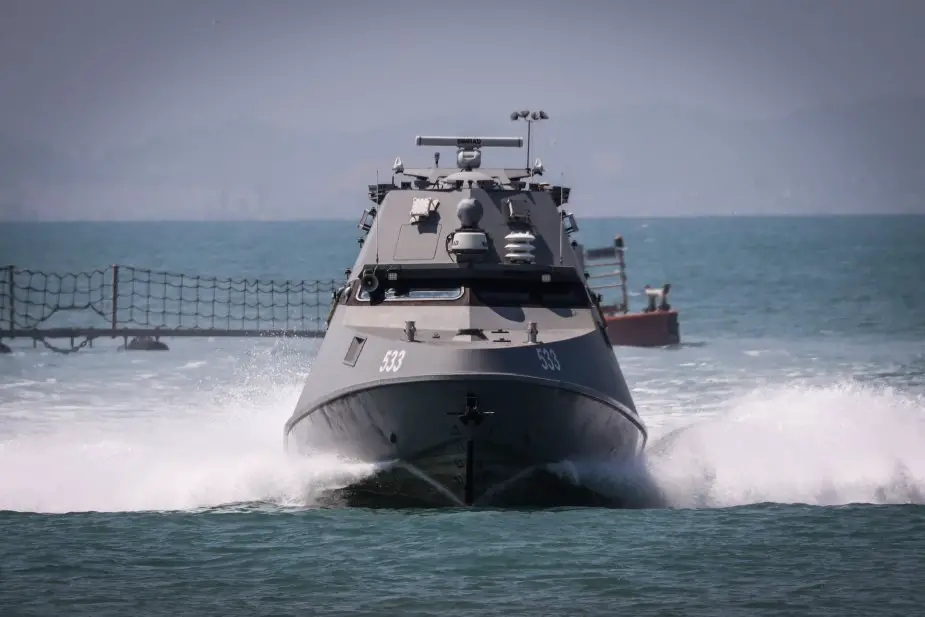Breaking news
Singapore Navy could deploy unmanned surface vessel by end 2021.
According to information published by MINDEF Singapore on March 1, 2021, Singapore Navy could deploy unmanned surface vessel. Developed in close partnership with the Defence Science & Technology Agency (DSTA) and DSO National Laboratories, the new USV harnesses the latest technologies to enable autonomous operations in dense and complicated maritime environments.
Follow Navy Recognition on Google News at this link
 Republic of Singapore Navy’s new Maritime Security Unmanned Surface Vessels (Picture source:Twitter)
Republic of Singapore Navy’s new Maritime Security Unmanned Surface Vessels (Picture source:Twitter)
Soon, the RSN’s new Maritime Security Unmanned Surface Vessels (MARSEC USVs) will operate alongside manned ships such as the RSN’s Littoral Mission Vessels (LMVs) to enhance the security of Singapore’s waters.
The USVs are equipped with autonomous navigation systems and an indigenously-developed Collision Detection and Collision Avoidance (CDCA) system that enable the vessel to navigate through the busy traffic in the Singapore Strait and cope with the constantly changing wind and current conditions at sea.
The CDCA system, developed by DSTA and DSO, integrates the USV’s sensors and collision detection equipment used for manned maritime navigation (such as navigation charts, Maritime Automatic Identification System and Differential Global Positioning System) with an algorithm designed specifically for the RSN’s operations in the Singapore Strait. The Artificial Intelligence-driven system automates the collision avoidance decision-making process while ensuring that the USVs exhibit avoidance behaviour that complies with the Convention on the International Regulations for Preventing Collisions at Sea.
To design this algorithm, engineers from DSTA and DSO gathered and analysed maritime traffic pattern of the Singapore Strait. The algorithm was tested in simulation runs in DSO laboratories using collected maritime data. After more than nine months of rigorous testing and validation of collision-free simulation runs, the CDCA system was installed on board the USVs. Initial trials at sea to validate the system were conducted with safety crew on board and after robust testing, the MARSEC USVs are now ready for fully autonomous sea trials.
The USVs will add another layer of surveillance and operational response to our maritime borders. They are able to conduct round-the-clock patrols, investigate and interdict suspicious vessels in our waters. Operating alongside other manned vessels, the USVs will enhance the RSN’s ability to monitor and respond to situations at sea. By providing more persistent coverage in the Singapore Strait, the USVs also allow larger warships like the LMVs to be deployed more strategically for other missions and at further ranges from Singapore. Similar to the Mine Countermeasure USVs, the MARSEC USVs allow our servicemen to remotely and safely conduct potentially dangerous missions at sea.
The vessel can be operated by two operating crew, as compared to the manned LMV that requires a base crew of 23. This is enabled by the USV’s ability to navigate autonomously. In addition, the user-centric design of the Unmanned Systems Mission Control allows the operators to quickly plan and execute patrol profiles, track vessels of interest, and remotely warn, query and investigate vessels at sea.
The USV teams will be “National Service-by-design”. In its steady state, the USV teams, consisting of operators and engineering support, will mainly be made up of full-time and Operationally Ready National Servicemen, and a small complement of Regulars.
USV has a length of 16,9m and a beam of 5,2m. The system is capable to reach speeds going up to 25 knots.



















